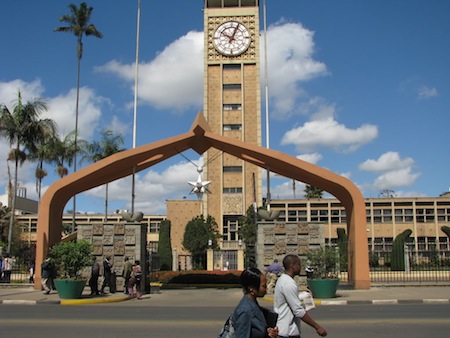Much of the attention on today’s Kenyan election has focused on the presidential race — and that’s as it should be, given that Kenya’s president wields much power, and the race is essentially even between Jubilee coalition candidate Uhuru Kenyatta and the Coalition of Reform and Democracy (CORD) alliance candidate Raila Odinga.![]()
But Kenya is also holding parliamentary and local elections for the first time after adopting its new 2010 constitution, which changes much about the way that Kenya is governed, and those elections are as historic as the presidential election is frenzied.
The heart of the new electoral system is the country’s organization into 47 sub-national counties, which have been given new powers for local governance. Indeed, today’s election will select not only new national legislators, but also a governor and county assemblies.
The electoral reforms make Kenya’s presidency less powerful, but to the benefit of the counties, not to the benefit of the parliament.
Nonetheless, the new constitution also expands the national parliament and changes the way legislators are elected, based again on the newly delineated 47 counties.
The National Assembly — what used to be Kenya’s unicameral parliament — is now just the lower house of a bicameral parliament, which will also include an upper house, the Senate, after today’s election.
The novelty of the 2010 constitutional reforms makes it even trickier to forecast what the result will be, and the nature of Kenyan politics doesn’t make it any easier. Given that Kenyan politics is largely based on ethnic identity, the Jubilee and CORD camps are patchwork alliances of various ethnic groups throughout Kenya. Although the alliances are technically comprised of parties, many of those parties are also ethnicity-based or even just transitory vehicles that exist to boost the career of one particular politician.
Accordingly, Kenya lacks political parties rooted on the traditional left/right ideological spectrum, unless you count the Kenya African National Union (KANU), the governing party in Kenya until 2002 — because it was the dominant party in a one-party state for much of the 1960s, through the 1990s, its predominant ideology was perpetuating its hold on power.
That means since 2002, Kenyan politics has been dominated by temporary alliances instead of enduring political parties — the National Rainbow Coalition (NARC) emerged to support the candidacy of Mwai Kibaki in 2002, and it likewise won a large majority of seats in the National Assembly.
In the aftermath of the 2007 election — widely believed to have been marred by fraud — Kibaki controversially held onto power in the presidential race, though Odinga’s Orange Democratic Movement (ODM) essentially won the parliamentary elections. Accordingly, in early 2008, Kibaki and Odinga agreed to a power-sharing truce whereby Kibaki remained as president and Odinga would become prime minister, making Kenya one of the rare countries in Africa to feature divided government.
One of the fascinating questions this time around, given the closeness of the presidential race, is whether Kenya could see another term of split government — and what that would mean for Kenya’s governance.
If Kenyatta wins the presidency and Odinga ultimately becomes prime minister because his allies control Kenya’s parliament, it will mirror the positions each candidate’s father held exactly 50 years ago in the aftermath of independence — Jomo Kenyatta was Kenya’s first president and Jaramogi Oginga Odinga was Kenya’s first vice president. The conserve scenario — an Odinga presidency and a Kenyatta-controlled parliament — would be perhaps an even more ironic result.
The current National Assembly (elected under the old constitution) features 224 seats, a majority of which are currently Odinga allies Odinga’s ODM holds the largest bloc, 100 seats, and the Wiper Democratic Movement, with 17 seats, is led by Odinga’s running mate, Kalonzo Musyoka.
Kibaki’s Party of National Unity holds 47 seats and, while it’s not much of a key player in the current election, it is supporting Kenyatta in the presidential race.
Although Kenyatta led KANU, with 14 seats, until April 2012, when he promptly left the party, it’s now led by Gideon Moi (son of former president Daniel arap Moi), supporting neither Kenyatta nor Odinga, but deputy prime minister Musalia Mudavadi.
Smaller parties hold an additional 34 seats, and 12 members are ex officio or presidential appointees.
So to the extent there’s any power of incumbency, it lies with Odinga and the CORD alliance. But if Kenyatta wins a blowout victory today, that won’t matter much, given that many Kenyans aren’t expected to split their votes between the presidential and parliamentary elections.
Under the new constitution, the National Assembly will be expanded to 350 members — 290 of those members are elected directly in single-member districts (that’s similar to the old system). An additional 47 members are reserved exclusively for women, and each county will elect a woman to represent it in the National Assembly. Twelve further seats are reserved for special interest groups, such as young voters or people with disabilities.
The Senate will have 68 members — each of Kenya’s 47 counties will elect one senator on a first-past-the-post basis. In addition, 16 seats are reserved for women (as in the National Assembly), which will be elected on a party-list basis in proportion to the seats each party holds on the basis of the 47 direct-election contests. Two further seats are reserved for youth, and two seats are reserved for people with disabilities.
In addition, each of the National Assembly and the Senate will elect an ex officio speaker.

One thought on “Could Kenya enter another period of power-sharing after its general election?”